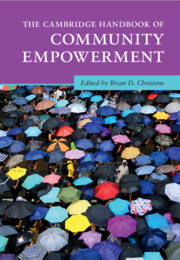Book contents
- The Cambridge Handbook of Community Empowerment
- Cambridge Handbooks in Psychology
- The Cambridge Handbook of Community Empowerment
- Copyright page
- Contents
- Figures
- Tables
- Contributors
- Building Community Power
- Part I Organizing and Activism
- Part II Participatory Governance
- 7 Citizens’ Governance Spaces
- 8 Participatory Budgeting
- 9 Participatory Urban Planning
- 10 Youth Policy Advocacy in Municipal Governance
- Part III Civil Society and Coalitions
- Part IV Enterprise
- Part V Participatory and Community Arts
- Part VI Education and Engaged Research
- Contributor Details
- Index
- References
9 - Participatory Urban Planning
from Part II - Participatory Governance
Published online by Cambridge University Press: 18 April 2024
- The Cambridge Handbook of Community Empowerment
- Cambridge Handbooks in Psychology
- The Cambridge Handbook of Community Empowerment
- Copyright page
- Contents
- Figures
- Tables
- Contributors
- Building Community Power
- Part I Organizing and Activism
- Part II Participatory Governance
- 7 Citizens’ Governance Spaces
- 8 Participatory Budgeting
- 9 Participatory Urban Planning
- 10 Youth Policy Advocacy in Municipal Governance
- Part III Civil Society and Coalitions
- Part IV Enterprise
- Part V Participatory and Community Arts
- Part VI Education and Engaged Research
- Contributor Details
- Index
- References
Summary
Comprehensive citywide planning is a practice that many cities undertake regularly. In theory, the principles laid out in citywide plans can help guide the distribution of public and private investments that shape the future development of that city. In recent years, many major cities have been incorporating equity goals and frameworks into planning efforts in attempts to close long-standing racial gaps. Although urban planning, as a field, has espoused goals of participation and shared power in development decisions, power and influence is often concentrated among wealthier households and institutions. Participation in planning processes often involves conflict between opposing interests, and development outcomes are often inequitable. Comprehensive planning has the potential to change some development rules and processes that lead to inequitable outcomes, but this is contingent upon shifting power and influence away from wealthy and elite citizens and institutions. Research on power and empowerment is critical to understanding how influence is manifested through planning policies and processes. The City of Chicago’s “We Will Chicago” plan provides a case example of how city planning processes attempt to engage stakeholders in developing a vision and goals that align with traditionally marginalized groups.
Keywords
- Type
- Chapter
- Information
- The Cambridge Handbook of Community Empowerment , pp. 241 - 261Publisher: Cambridge University PressPrint publication year: 2024

